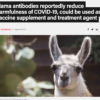Triple J Farms has developed a method of monitoring passive transfer in the newborn llama by using a radial immunodiffusion test. To date we have monitored over 300 mother IgG colostrum titers and the next day serum levels of IgG in the cria. By observation of the cria's activity, weight gain, and general health we have determined what we consider to be adequate IgG levels in the 24 hour cria. A cria may not achieve this level due to a difficult birth, poor milk, improper sucking reflex, lowered body temperature, etc.
A technique to raise the IgG level can be substitute colostrum within 16 hours of birth. Passive transfer for the newborn occurs over the first 24 hours. In calves a newborn absorbs intact colostral proteins for the first few hours through the gut walls. Within 6 hours this ability is reduced by 1/3 and by 24 hours only 11% can be absorbed. Colostral antibodies are not species specific and cow or goat antibodies can give initial protection to the newborn cria. Even if the baby needs a transfusion you should make an effort to get some colostrum into the newborn, preferably from the mother but whatever is available will do. Colostrum should be thick and light yellow in color. This indicates it is close to the first collection from the animal source. Colostrum with a consistency of milk has been collected much later and contains low levels of protective antibodies. Breeders should always know the quality of colostrum used for supplementing. Over the past nine years babies from surrounding farms have been supplemented with cow colostrum in measured amounts. We have found in our study that absorption of cow IgG has ranged from 2% to 26%. Animals with poor absorption were premature and their absorption rate improved over a couple of days. Cold babies with lowered body temperatures also had poor absorption. Animals averaged 13% absorption in 24 hours. Titers on the seven lots of cow colostrum supplemented ranged from 3400 mg/dl to 9400 mg/dl IgG, average being 5743 mg/dl. Colostrum was pooled from a commercial dairy cattle herd located in our state. On an average cria of 23 pounds, we had to supplement 1000 to 1500 mls of good cow colostrum to give a cria adequate protective antibodies.
Donor plasma can be transfused by Intravenous (I.V.) or Intraperitoneal (I.P.) routes. Both techniques have had the same absorption values of IgG when we have evaluated transfused IgG levels. We like the I.P. over I.V. method because it's quicker, 10 minutes versus 1 or 2 hours, therefore less stressful. It also eliminates the often difficult procedure of inserting a catheter into the jugular vein.
Probably the major cause of baby llama or alpaca death in the first month is septicemia. One of the methods of combating septicemia is naturally occurring immunoglobulin IgG. Unfortunately the baby does not have the ability to manufacture adequate amounts of IgG for the first 6 weeks of life so it is most important to receive colostrum from the mother. This is the only "natural" source of concentrated IgG available to the newborn. By monitoring IgG levels at 18 to 24 hours in the newborn llama we can determine if the baby has absorbed IgG from the llama colostrum. Low levels of IgG indicates the babies are at risk for future health problems. We then must inject donor plasma into the babies peritoneal cavity or by I.V. to carry the baby through the first few weeks of life.
When the failure of passive transfer occurs it is usually a partial failure. This means the baby has absorbed some colostrum from the mother giving it protective antibodies. This will be effective for several days or weeks, but possibly not enough to last several months at a reasonable level.
You can determine the supplemental IgG needed by taking the target level (800 mg/dl) and subtracting the IgG level that has occurred. An example would be a baby with a partial transfer of 300 mg/dl. We want to supplement the baby 500 mg/dl. (Target level minus passive transfer that occurred). You can estimate the blood volume of a baby at 7% body weight. To work in metric convert the baby's weight from pounds to kilos. In this example the baby weighs 22 pounds. There is 2.2 lbs in a kilo therefore 22 pounds * 2.2 = 10 kilos. 10 kilos multiplied by 7% or .07 = .7 liters, 700 mls, or 7 deciliters. You want to supplement the 7 deciliters of blood with 500 mg of IgG per deciliter or 7 x 500 mg = 3500 mg IgG to supplement. With an average of roughly a 33% absorption you need to give three times your calculations or 3500 mg x 3 = 10,500 mg IgG. Depending on the titer of your donor animal you can calculate what volume of plasma you have to give. If your donor is 1500 mg/dl you have to give 10,500 * 1500 or 700 mls. If the donor titer is 2500 mg/dl you give 10,500 * 2500 or 420 mls. The higher the donor plasma titer the lower the volume of plasma that needs to be transfused. It is also essential that you know the titer (mg/dl) of the plasma to be transfused. Poor transfusions that have had little or no benefits have been from donor plasma that has an unknown concentration. Breeders may use the nearest available animal, draw some blood, prepare plasma, and transfuse the baby. Frequently these animals will have IgG concentrations of less than 1000 mg/dl. If a limited amount of this plasma is used (100-300 mls) it will have little effect in raising the IgG level of the baby, particularly if a low grade infection is already in progress. This can often be the case without any outward clinical symptoms.
Blood is drawn from the donor animal into a sterile receptacle. It is then centrifuged to separate the plasma from the red blood cells. Plasma can be stored frozen for up to a year. It can be thawed and heated for transfusion in warm water. DO NOT MICROWAVE!!
When giving an intraperitoneal transfusion we put the baby on a table with the right side up. With one person holding, triangulate an area in the flank between the front of the back thigh, the last rib and the backbone. We then shave a two inch square. A vein should be observed. We make our incision site below the vein. We scrub the area followed by a .1cc injection of lidocaine in the incision site. We cut a 3mm incision in the skin and push a 3 inch blunt tipped, 2 port udder infusion tube through the incision and peritoneal wall. The blunt tip is for safety since it must not nick or cut any internal organs it might touch. A sharp needle might lacerate internal organs if the animal starts to struggle. Some people have tried using teflon catheters but have encountered bending or pinching at the peritoneal wall. We run in warm plasma as rapidly as possible into the cavity. We pull the tube when finished and spray the site with powdered furizone. We give the baby 1cc of Banamine for discomfort and possible inflammation and three days of antibiotics (usually procaine penicillin twice a day) prophalacticly.
This description is to familiarize llama owners with the intraperitoneal procedure. We are not suggesting this procedure should be done by anyone other than a veterinarian. Statistically we have found that only about one in twelve requires the plasma transfusion.
After seven years of I.P.'s we now use the following rule of thumb: babies that weigh 18 to 22 lbs, transfuse 300 to 500 mls of plasma; 23 to 30 lbs, 500 to 1000 mls of plasma; and babies up to 37 lbs, no more than 1000 mls. Babies' comfort is important and they begin to feel uncomfortable when too much plasma is given. IgG titers from the transfusion increase up to 48 hours. Average absorption of the IgG has ranged from 13% to 61% with a median of 34% on 78 transfusions. (*See Table 1.) This emphasizes the importance of immunized donor animals. If you can give only 300 mls to a baby because of its size, you need the IgG titer of the donor to be as high as possible preferably in the area of 2500 mg/dl.
We check the crias IgG titer at 48 hours and if the IgG titer is between 300 and 700 mg/dl and the baby is acting healthy, we wait two days and give another I.P. transfusion. We expect the babies IgG titer to be above 800 mg/dl when the next test is taken in 48 hours.
We use aseptic technique in all procedures. The babies are allowed back into the pastures after the transfusion, which takes approximately 10 minutes. We are not the first farm to use this method, although it is the first time documentation has been offered to indicate how the IgG titer is affected with guidelines on volumes of plasma transfused. We favor this method because the minimal time it requires results in less stress on the animal. We also avoid having to find the jugular vein in dehydrated babies and securing the catheter.
Intraperitoneal transfusions should not be given when a baby has intestinal distress, sour stomach, subnormal body temperature, or is lethargic. This would cause the baby to lay around and possibly not absorb plasma as readily as an active baby.
As a follow up on monitoring and making sure IgG titers are above 800 mg/dl for newborns, a blood test is taken when llamas are weaned to determine the normal titer for older animals. The goal is to determine if there was any relationship between 24 hour titers and the weaning titer at four to six months. This data is in Table 2. At this time there does not appear to be a correlation. Additional data being collected is listing the weight of the weaned animal to determine if nutrition might affect weaning titers. Correlation is not apparent at this time.
By testing a large number of healthy, normal, weanling (4 to 6 month) llamas we can show lower than newborn IgG levels are expected and in fact normal. We are frequently questioned about normal levels for weanlings and older llamas. The average passive transfer titer measured at 18 to 24 hours in a newborn llama in the Pacific Northwest is 1658 mg/dl based on 230 samples. This article discusses transfusions for animals that are less than 50% of normal or what we term "at risk babies". By four to six months of age we see normal healthy animals with a range of IgG concentrations from 375 mg/dl to 1560 mg/dl and an average of 699 mg/dl on 79 samples. By the time llamas reach 2 years of age or older they have an average IgG concentration of 1574 mg/dl ranging from 865 mg/dl to 2454 mg/dl.
Some insurance companies have requested a minimum IgG level in order to continue insuring baby llamas. This level has been set at 800 mg/dl. Since this minimum has become a standard requirement for Wilkens Livestock Insurance Company, mortality for newborns treated has virtually been eliminated. This company had previously reported their underwriters were ready to eliminate insurance coverage for llamas under 3 months due to the severely high death rate. There are species of exotic livestock that cannot be insured under three months of age because of their high mortality rate.
Previous studies on only a few animals bled every 3 days after birth for 30 days shows the animal with titers of 800 mg/dl drop to around 200 mg/dl on day 27, climbing to 350 on day 31 and increasing thereafter. Dr. Donald Mattson at Oregon State University is currently trying to establish normals on yearling llamas based on approximately 700 samples. This should help us to determine IgG levels in llamas of different ages.
Dr. Walter Bravo at the University of California is closely monitoring IgG levels on newborn llamas and alpacas in Peru to determine what happens in a natural environment without intervention of colostrum supplements or plasma transfusions. His study in January of 1992 monitored newborn llamas and alpacas and their average IgG levels over the first sixty days of life. Initial data is very similar to the numbers we are observing in North America with crias dropping to roughly 400 or 500 mg/dl by sixty days.
This data we trust will contribute to the understanding of the young llamas' immune system and the relevance of using the IgG test to monitor their health status. All numbers given in this paper were determined by using the Triple J Farm radial immunodiffusion test. These numbers will not necessarily agree with numbers determined by other testing methods or RID tests manufactured by other companies.





